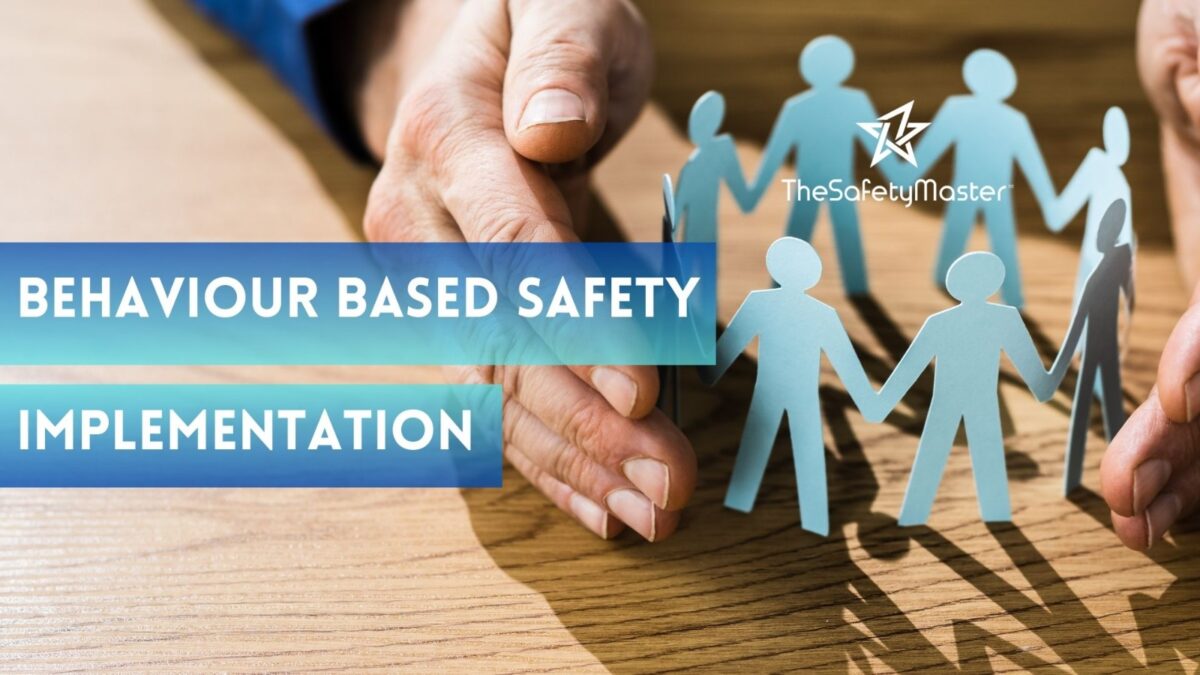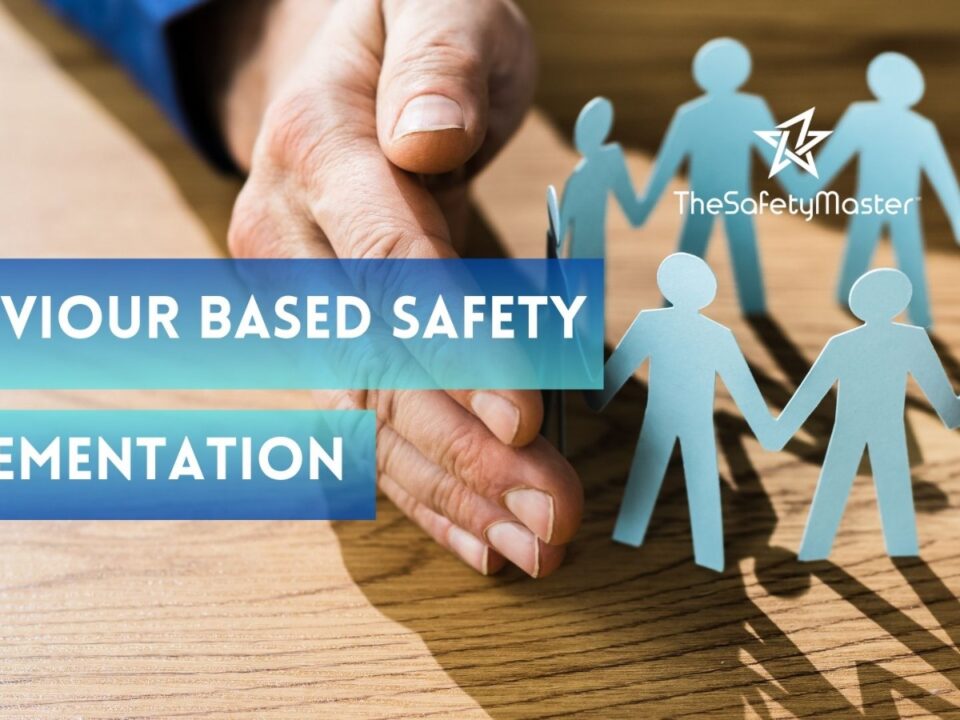Bridging the Gap: Implementing Behaviour-Based Safety for a Safer Manufacturing Workplace

Enhancing Steel Safety: Process Management for Optimal Operations
December 30, 2023
How Process Hazard Analysis Elevates Safety Standards in Indian Process Industries
January 4, 2024In this article, we delve into the pressing concerns plaguing the manufacturing industry and present a solution that guarantees a safer workplace. Bridging the Gap: Implementing Behaviour-Based Safety is the key to fostering a culture of safety within manufacturing facilities. Discover how this proactive approach can significantly reduce accidents and injuries, while enhancing productivity. From identifying potential hazards to empowering employees, we unveil the step-by-step process to ensure a secure work environment. Embark on this reading journey as we promise to equip you with invaluable insights that will revolutionize your approach to safety in manufacturing. Safety is not just a priority – it’s a promise we make to our hardworking employees.
Introduction
The manufacturing industry is a dynamic and fast-paced sector that plays a crucial role in our modern society. However, amidst the hustle and bustle of production lines, heavy machinery, and intricate processes, safety can sometimes be overlooked. This neglect can lead to accidents, injuries, and even fatalities. It is essential for manufacturers to prioritize safety in the workplace, ensuring the well-being of their employees while maintaining optimal productivity. In this article, we will delve into the concept of Behaviour-Based Safety (BBS) as a powerful tool for bridging the gap between potential hazards and a safer manufacturing workplace. We will explore the benefits of implementing BBS programs and provide insights into key behaviours and hazards specific to manufacturing environments. Additionally, we will discuss how to develop comprehensive safety observation programs, effectively train and engage employees in BBS practices, establish feedback systems that encourage positive reinforcement, analyse data for continuous improvement, and overcome challenges associated with implementing BBS initiatives
Understanding Behaviour-Based Safety in a Manufacturing Workplace
In the realm of manufacturing, embracing Behaviour-Based Safety (BBS) is crucial for fostering a safer workplace environment. BBS focuses on understanding human behaviour and its impact on occupational safety. By recognizing that human actions, both conscious and unconscious, play a significant role in workplace incidents, manufacturers can implement proactive strategies to mitigate risks effectively. To comprehend the foundations of BBS, it is essential to acknowledge the concept of “at-risk behaviours” and “safe behaviours.” At-risk behaviours encompass actions or choices that increase the likelihood of accidents or injuries occurring. Conversely, safe behaviours are those that align with established safety protocols and reduce potential hazards.
Behaviour-Based Safety aims to identify not only individual at-risk behaviours but also organizational factors influencing safety performance. This holistic approach enables manufacturers to analyse patterns, root causes behind unsafe practices, and implement targeted interventions. By delving into the psychology behind employee decision-making processes, manufacturers can create an environment that fosters positive change while emphasizing prevention rather than reaction.
Promoting a culture of safety is instrumental in implementing Behaviour-Based Safety in manufacturing workplaces. This cultural shift involves cultivating open communication channels where employees feel empowered to report potential risks without fear of repercussions. Additionally, fostering trust between management and workers encourages active engagement in identifying hazards and adopting safer practices.
In essence, understanding Behaviour-Based Safety within a manufacturing context empowers organizations to proactively address risky behaviours while promoting a collective commitment towards safety. By focusing on human behaviour as an integral component of workplace incidents, manufacturers can cultivate a positive work environment where employees feel valued and secure while maximizing productivity levels.
Benefits of Implementing Behaviour-Based Safety Programs
Incorporating behaviour-based safety programs into a manufacturing workplace has numerous benefits. Firstly, it creates a culture of accountability and responsibility, where employees actively participate in ensuring their own safety and that of their colleagues. This promotes a sense of ownership and empowerment among workers, leading to increased morale and job satisfaction. Secondly, behaviour-based safety programs have proven to be highly effective in reducing workplace accidents and injuries. By focusing on identifying key behaviours that contribute to hazards, organizations can proactively address potential risks before incidents occur. This not only safeguards the well-being of employees but also minimizes production downtime due to accidents, resulting in improved efficiency and profitability.
Lastly, implementing behaviour-based safety programs fosters stronger teamwork and communication within the manufacturing environment. By encouraging employees to observe and provide feedback on each other’s behaviours regarding safety practices, collaboration is enhanced. This strengthens relationships among team members and promotes a collective commitment to maintaining a safe work environment.
By embracing behaviour-based safety programs, manufacturers have the opportunity to create a workplace where every employee feels valued, protected, and motivated. It is an investment that not only protects lives but also drives success through increased productivity and employee engagement.
Identifying Key Behaviours and Hazards in the Manufacturing Workplace
In the fast-paced environment of a manufacturing workplace, identifying key behaviours and hazards is crucial for ensuring a safer work environment. By closely examining the actions and routines of employees, we can uncover both positive safety practices and potential risks that may lead to accidents or injuries. One key behaviour worth recognizing is the consistent use of personal protective equipment (PPE) by all employees. Whether it’s wearing safety goggles, gloves, or helmets, this simple act demonstrates a commitment to personal safety and sets an example for others. Additionally, monitoring adherence to proper lifting techniques among workers can significantly reduce the risk of musculoskeletal injuries.
Moreover, hazard identification plays an essential role in creating a safe workplace. This involves carefully assessing the various tasks performed by employees and pinpointing potential dangers associated with them. For instance, identifying slip and trip hazards such as wet floors or loose cables can help prevent falls. By actively observing these behaviours and hazards, we can effectively develop targeted strategies that bridge gaps in safety protocols while fostering a culture of constant improvement within the manufacturing workspace.
Developing a Comprehensive Safety Observation Program
Developing a Comprehensive Safety Observation Program Within the realm of behaviour-based safety, one critical aspect is the establishment of a comprehensive safety observation program. This program serves as the eyes and ears of an organization, allowing for the systematic identification and documentation of unsafe behaviours or conditions. By implementing such a program, manufacturing workplaces can proactively identify potential hazards and take proactive measures to mitigate risks.
To develop an effective safety observation program, it is crucial to involve employees at all levels. Through open communication channels and regular training sessions, workers can be educated about the importance of observations and encouraged to actively participate in identifying potential safety issues. Additionally, establishing specific guidelines for conducting observations ensures consistency and accuracy in data collection.
Furthermore, incorporating technology into the safety observation program can streamline the process and enhance its effectiveness. Utilizing mobile applications or wearable devices allows real-time reporting of observations, ensuring swift action can be taken to rectify any hazards identified. Embracing technology not only empowers employees but also creates a culture of continuous improvement where safety becomes ingrained in every aspect of day-to-day operations.
Remember that a comprehensive safety observation program is not just about identifying unsafe acts; it should also celebrate positive behaviours that contribute to a safer workplace. By recognizing individuals who consistently adhere to safe practices, organizations place emphasis on reinforcing desired behaviours rather than solely focusing on corrective actions. This positive reinforcement fosters an optimistic atmosphere where employees feel valued and motivated to proactively engage in creating a safer manufacturing environment for all.
Training and Engaging Employees in Behaviour-Based Safety
Training and Engaging Employees in Behaviour-Based Safety: Ingraining a culture of safety within a manufacturing workplace is not solely dependent on policies and procedures. It requires the active participation and engagement of every employee. Training plays a pivotal role in ensuring that employees understand the principles of behaviour-based safety (BBS) and can effectively apply them in their daily tasks.
To begin, training sessions should be meticulously designed to capture participants’ attention. Interactive workshops that incorporate real-life scenarios and hands-on activities foster a deeper understanding of BBS concepts. By encouraging employees to actively participate in discussions, share their experiences, and collaborate with colleagues, they become more invested in implementing safe behaviours.
Furthermore, engaging employees goes beyond just providing training sessions. Creating open lines of communication allows for ongoing dialogue about safety concerns and suggestions for improvement. Regular toolbox talks or safety meetings provide opportunities for employees to exchange ideas, ask questions, and reinforce their commitment to working safely. By fostering an inclusive environment where everyone’s voice is valued, organizations can unlock the collective knowledge and experience of their workforce.
In conclusion, training employees on behaviour-based safety is not only about imparting knowledge but also about empowering individuals to take ownership of their own safety as well as that of their colleagues. Through interactive learning experiences and ongoing engagement initiatives, organizations can instil a sense of pride among employees as they actively contribute to creating a safer manufacturing workplace.
Implementing Effective Feedback and Recognition Systems
Implementing Effective Feedback and Recognition Systems: To foster a culture of safety in a manufacturing workplace, it is crucial to establish robust feedback and recognition systems. These systems serve as powerful tools for reinforcing positive behaviours and encouraging continuous improvement. By providing timely feedback, employees become more aware of their actions and can make necessary adjustments to ensure a safer working environment.
One effective approach is to implement a peer-to-peer feedback system, where employees are encouraged to provide constructive criticism and acknowledge exemplary safety practices. This encourages collaboration and creates a sense of accountability among team members. Additionally, regular safety meetings can be used as platforms to recognize individuals who consistently adhere to safety protocols, creating a positive atmosphere that motivates others to do the same.
Incorporating creative recognition methods can further enhance the impact of these systems. From safety-themed contests and awards to public acknowledgments through newsletters or notice boards, organizations have an opportunity to celebrate individual contributions while reinforcing the importance of safe practices collectively. By emphasizing the significance of each employee’s role in maintaining a secure workplace, these recognition systems not only improve engagement but also instil a sense of pride in accomplishing shared goals.
Remember, effective feedback and recognition systems are not only about praising achievements but also about providing constructive suggestions for improvement. By combining positive reinforcement with opportunities for growth, organizations can create an environment that values continuous learning and fosters a culture where safety becomes ingrained in every employee’s mind-set.
Analysing Data and Evaluating the Effectiveness of Behaviour-Based Safety Initiatives
The crux of any successful behaviour-based safety program lies in its ability to collect and analyse data, as well as evaluate the effectiveness of implemented initiatives. This crucial step allows organizations to make informed decisions and refine their strategies to ensure continuous improvement in workplace safety. When it comes to analysing data, a comprehensive approach should be adopted. By examining incident reports, near misses, and safety observation records, patterns can be identified, highlighting areas that require immediate attention. Additionally, by delving into injury records and workers’ compensation claims, organizations can gain valuable insights into the root causes of accidents, enabling them to implement targeted interventions.
But this analysis is not limited to reactive measures alone; proactive monitoring is equally essential. Regularly conducting safety audits and inspections can help identify potential hazards before they lead to accidents or injuries. Furthermore, tracking leading indicators such as employee engagement in safety programs or adherence to safe work procedures provides a proactive measure of success.
Evaluating the effectiveness of behaviour-based safety initiatives involves more than just crunching numbers; it requires a holistic approach that considers both quantitative and qualitative factors. Conducting employee surveys or focus groups allows for gathering first-hand experiences and feedback from those directly involved in the program. This qualitative data complements the quantitative metrics by providing deeper insights into how employees perceive changes in safety culture and their overall satisfaction with the initiative.
By diligently analysing data from multiple sources while incorporating qualitative feedback from employees, organizations can effectively measure improvements in safety performance over time. This evaluation process not only validates the efficacy of behaviour-based safety initiatives but also instils confidence among employees that their efforts are making a tangible difference in creating a safer workplace environment
Overcoming Challenges and Resistance to Behaviour-Based Safety Implementation
Overcoming Challenges and Resistance to Behaviour-Based Safety Implementation: Navigating through the tumultuous waters of change is no easy feat, especially when met with resistance and scepticism. The implementation of behaviour-based safety programs in a manufacturing workplace is no exception. However, with a strategic approach and unwavering determination, these challenges can be surmounted, paving the way for a safer and more harmonious work environment.
One of the key hurdles faced when introducing behaviour-based safety initiatives is the resistance from employees who may perceive it as an intrusion on their autonomy or an additional burden to their already demanding workload. To address this concern, it is crucial to emphasize the benefits and positive outcomes that can arise from embracing such programs. By highlighting how behaviour-based safety measures can enhance overall productivity, reduce accidents, and foster an atmosphere of trust and collaboration, employees are more likely to embrace the change with open minds.
Furthermore, organizational culture plays a pivotal role in overcoming resistance. It is essential for leaders to cultivate an environment that values open communication and encourages employee involvement in decision-making processes. By fostering a culture that promotes transparency and inclusivity, employees are more likely to feel empowered and invested in the success of behaviour-based safety initiatives. With strong leadership guiding them along this transformative journey, employees will realize that change is not only necessary but also beneficial for their well-being.
In conclusion, while challenges may arise during the implementation of behaviour-based safety programs in manufacturing workplaces, they can be overcome by emphasizing the advantages they bring forth while fostering a culture of openness and empowerment. By acknowledging these obstacles as stepping stones rather than obstacles impeding progress, organizations stand poised to create safer work environments where employees thrive both personally and professionally.
The Role of Leadership in Successfully Implementing Behaviour-Based Safety
The Role of Leadership in Successfully Implementing Behaviour-Based Safety in the intricate web of a manufacturing workplace, leadership serves as the guiding force that steers the ship towards a safer horizon. Leaders must embrace their pivotal role in implementing behaviour-based safety initiatives, becoming champions of change and catalysts for a culture focused on safety. They must possess an unwavering commitment to creating an environment where employees are empowered to prioritize safety above all else.
Effective leaders understand that their actions set the tone for the entire organization. By consistently modelling safe behaviours and actively participating in safety programs, leaders demonstrate their genuine dedication towards creating a secure workplace. They lead by example, inspiring others to follow suit and igniting a ripple effect of positive change throughout the organization.
Leadership involvement is not limited to mere participation but extends into fostering open lines of communication. Encouraging regular dialogue about safety concerns, suggestions, and ideas creates an atmosphere where employees feel heard and valued. By actively listening to their team members’ perspectives, leaders gain valuable insights into potential hazards or inefficiencies that may hinder safety efforts. This collaborative approach cultivates trust and empowers employees at all levels to take ownership of their own safety practices.
By embracing these principles of leadership, organizations can foster an optimistic environment where every employee feels supported, empowered, and inspired to make safe choices every day. Through effective leadership practices, behaviour-based safety becomes more than just a program; it becomes deeply ingrained within the fabric of the organization’s culture – ensuring a safer manufacturing workplace for everyone involved.
Enhancing Safety Culture through Continuous Improvement
Enhancing Safety Culture through Continuous Improvement: Building a strong safety culture is essential for a manufacturing workplace to thrive. It requires a commitment to continuous improvement, where every employee actively participates in creating a safer environment. One way to achieve this is by encouraging open communication channels and fostering a learning culture. By providing opportunities for employees to share their safety concerns, ideas, and suggestions, the organization can tap into the collective wisdom of its workforce.
Moreover, regular safety audits and inspections play a crucial role in identifying areas that need improvement. These assessments provide an opportunity to evaluate existing safety protocols and make necessary adjustments or additions. By involving employees in these processes, they feel empowered and valued as their input contributes directly to shaping the company’s safety practices.
Furthermore, celebrating successes and milestones within the organization can create a positive atmosphere that motivates employees towards exemplary safety performance. Recognizing individuals or teams for their dedication to maintaining a safe workplace not only encourages them but also inspires others to follow suit. Emphasizing the importance of continuous improvement fosters an optimistic mindset where employees strive to surpass previous achievements, resulting in an ever-evolving safety culture that ensures the well-being of all staff members.
Conclusion
The successful implementation of behavior-based safety programs in a manufacturing workplace holds the key to fostering a culture of safety and reducing incidents. By identifying key behaviors and hazards, developing comprehensive safety observation programs, and training employees to actively engage in safety practices, organizations can effectively bridge the gap between current practices and desired outcomes. Through the use of data analysis and continuous improvement, companies can continuously enhance their safety culture. As leaders take charge and demonstrate their commitment to employee well-being, optimism prevails as a brighter future awaits, where every worker returns home safely at the end of each day.




